formerly eScholarship Editions


|
|
|
|
Your request for similar items found 20 book(s). | Modify Search | Displaying 1 - 20 of 20 book(s) | |
| 1. | 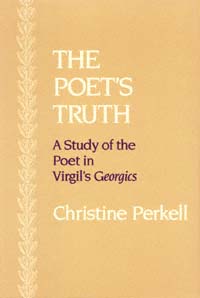 | Title: The poet's truth: a study of the poet in Virgil's Georgics Author: Perkell, Christine Published: University of California Press, 1989 Subjects: Classics | Classical Literature and Language Publisher's Description: The controversy over Virgil's optimism or pessimism, which has long absorbed readers of his poetry, might fruitfully yield to a perspective which allows contradictions to stand unresolved, to constitute, in fact, the essence of his poems' meaning. So interpreted, the pervasive contradictions of the Georgics are not problems to be solved, but expressions of the poet's vision of fundamental tensions in human experience.Focusing on the figure of the poet in his relationship to the farmer, Professor Perkell studies oppositions between power and beauty, profit and art, matter and spirit, which are critical to the poem's meaning. She points to the poet's privileging of myth over praeceptum , of divine revelation over experiment and practice, and of mystery over solution. The poem's oppositions find ultimate expression in the bougonia , literally false as Georgic precept but metaphorically true as image of Iron Age technology and culture. Through this metaphor, the poet suggests the high value of his own truth and implicitly challenges the values of the agricultural, material poem which the Georgics on its surface professes to be.Shaped by insights of reader-response and structuralist criticism, this new study of the Georgics should interest Classicists and students of literature. [brief] Similar Items |
| 2. | 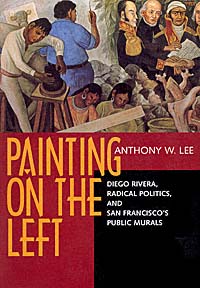 | Title: Painting on the left: Diego Rivera, radical politics, and San Francisco's public murals Author: Lee, Anthony W 1960- Published: University of California Press, 1999 Subjects: Art | Art History | Californian and Western History | California and the West Publisher's Description: The boldly political mural projects of Diego Rivera and other leftist artists in San Francisco during the 1930s and early 1940s are the focus of Anthony W. Lee's fascinating book. Led by Rivera, these painters used murals as a vehicle to reject the economic and political status quo and to give visible form to labor and radical ideologies, including Communism.Several murals, and details of others, are reproduced here for the first time. Of special interest are works by Rivera that chart a progress from mural paintings commissioned for private spaces to those produced as a public act in a public space: Allegory of California, painted in 1930-31 at the Stock Exchange Lunch Club; Making a Fresco, Showing the Building of a City , done a few months later at the California School of Fine Arts; and Pan American Unity , painted in 1940 for the Golden Gate International Exposition.Labor itself became a focus of the new murals: Rivera painted a massive representation of a construction worker just as San Francisco's workers were themselves organizing; Victor Arnautoff, Bernard Zakheim, John Langley Howard , and Clifford Wight painted panels in Coit Tower that acknowledged the resolve of the dockworkers striking on the streets below. Radical in technique as well, these muralists used new compositional strategies of congestion, misdirection, and fragmentation, subverting the legible narratives and coherent allegories of traditional murals.Lee relates the development of wall painting to San Francisco's international expositions of 1915 and 1939, the new museums and art schools, corporate patronage, and the concerns of immigrants and ethnic groups. And he examines how mural painters struggled against those forces that threatened their practice: the growing acceptance of modernist easel painting, the vagaries of New Deal patronage, and a wartime nationalism hostile to radical politics. [brief] Similar Items |
| 3. | 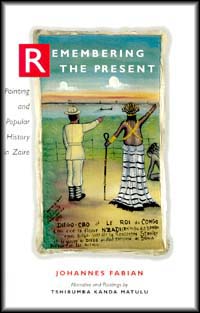 | Title: Remembering the present: painting and popular history in Zaire Author: Fabian, Johannes Published: University of California Press, 1996 Subjects: Anthropology | Cultural Anthropology | Art | African History | Politics | African Studies Publisher's Description: This book combines ethnography with the study of art to present a fascinating new vision of African history. It contains the paintings of a single artist depicting Zaire's history, along with a series of ethnographic essays discussing local history, its complex relationship to forms of self-expression and self-understanding, and the aesthetics of contemporary urban African and Third World societies. As a collaboration between ethnographer and painter, this innovative study challenges text-oriented approaches to understanding history and argues instead for an event- and experience-oriented model, ultimately adding a fresh perspective to the discourse on the relationship between modernity and tradition.During the 1970s, Johannes Fabian encouraged Tshibumba Kanda Matulu to paint the history of Zaire. The artist delivered the work in batches, together with an oral narrative. Fabian recorded these statements along with his own question-and-answer sessions with the painter. The first part of the book is the complete series of 100 paintings, with excerpts from the artist's narrative and the artist-anthropologist dialogues. Part Two consists of Fabian's essays about this and other popular painting in Zaire. The essays discuss such topics as performance, orality, history, colonization, and popular art. [brief] Similar Items |
| 4. | 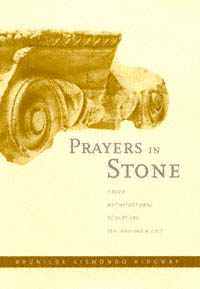 | Title: Prayers in stone: Greek architectural sculpture ca. 600-100 B.C.E Author: Ridgway, Brunilde Sismondo 1929- Published: University of California Press, 1999 Subjects: Classics | Art | Art and Architecture | Art History Publisher's Description: The meaning of architectural sculpture is essential to our understanding of ancient Greek culture. The embellishment of buildings was common for the ancient Greeks, and often provocative. Some ornamental sculpture was placed where, when the building was finished, no mortal eye could view it. And unlike much architectural ornamentation of other cultures, Greek sculpture was often integral to the building, not just as decoration, and could not be removed without affecting the integrity of the building structure. This book is the first comprehensive treatment of the significance of Greek architectural sculpture. Brunilde Sismondo Ridgway, a world-class authority on ancient Greek sculpture, provides a highly informative tour of many dimensions of Greek public buildings - especially temples, tombs, and treasuries - in a text that is at once lucid, accessible, and authoritative.Ridgway's pragmatism and common sense steer us tactfully and clearly through thickets of uncertainty and scholarly disagreement. She refers to a huge number of monuments, and documents her discussions with copious and up-to-date bibliographies. This book is sure to be acknowledged at once as the standard treatment of its important topic. [brief] Similar Items |
| 5. | 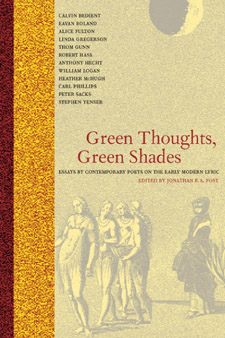 | Title: Green thoughts, green shades: essays by contemporary poets on the early modern lyric Author: Post, Jonathan F. S 1947- Published: University of California Press, 2002 Subjects: Literature | Poetry | Renaissance Literature Publisher's Description: Green Thoughts, Green Shades is a strikingly original book, the first and only of its kind. Edited and introduced by noted seventeenth-century scholar Jonathan Post, it enlists the analytic and verbal power of some of today's most celebrated poets to illuminate from the inside out a number of the greatest lyric poets writing in English during the sixteenth and seventeenth century. Written by people who spend much of their time thinking in verse and about verse, these original essays herald the return of the early modern lyric as crucial to understanding the present moment of poetry in the United States. This work provides fascinating insights into what today's poets find of special interest in their forebears. In addition, these discussions shed light on the contributors' own poetry and offer compelling clues to how the poetry of the past continues to inform that of the present. [brief] Similar Items |
| 6. | 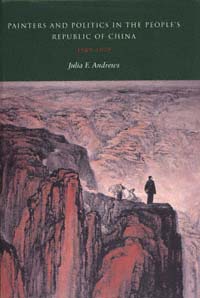 | Title: Painters and politics in the People's Republic of China, 1949-1979 Author: Andrews, Julia Frances Published: University of California Press, 1995 Subjects: Art | Art History | Asian Studies | China Publisher's Description: Julia Andrews's extraordinary study of art, artists, and artistic policy during the first three decades of the People's Republic of China makes a major contribution to our understanding of modern China. From 1949 to 1979 the Chinese government controlled the lives and work of the country's artists - these were also years of extreme isolation from international artistic dialogue. During this period the Chinese Communist Party succeeded in eradicating most of the artistic styles and techniques it found politically repugnant. By 1979, traditional landscape painting had been replaced by a new style and subject that was strikingly different from both contemporary Western art and that of other Chinese areas such as Taiwan, Hong Kong, and Singapore.Through vivid firsthand accounts, Andrews recreates the careers of many individual artists who were forced to submit to a vacillating policy regarding style, technique, medium, and genre. She discusses the cultural controls that the government used, the ways in which artists responded, and the works of art that emerged as a result. She particularly emphasizes the influence of the Soviet Union on Chinese art and the problems it created for the practice of traditional painting.This book opens the way to new, stimulating comparisons of Western and Eastern cultures and will be welcomed by art historians, political scientists, and scholars of Asia. [brief] Similar Items |
| 7. | 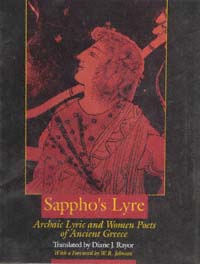 | Title: Sappho's lyre: archaic lyric and women poets of ancient Greece Author: Rayor, Diane J Published: University of California Press, 1991 Subjects: Classics | Classical Literature and Language | Literature in Translation | Poetry Publisher's Description: Sappho sang her poetry to the accompaniment of the lyre on the Greek island of Lesbos over 2500 years ago. Throughout the Greek world, her contemporaries composed lyric poetry full of passion, and in the centuries that followed the golden age of archaic lyric, new forms of poetry emerged. In this unique anthology, today's reader can enjoy the works of seventeen poets, including a selection of archaic lyric and the complete surviving works of the ancient Greek women poets - the latter appearing together in one volume for the first time. Sappho's Lyre is a combination of diligent research and poetic artistry. The translations are based on the most recent discoveries of papyri (including "new" Archilochos and Stesichoros) and the latest editions and scholarship. The introduction and notes provide historical and literary contexts that make this ancient poetry more accessible to modern readers.Although this book is primarily aimed at the reader who does not know Greek, it would be a splendid supplement to a Greek language course. It will also have wide appeal for readers of' ancient literature, women's studies, mythology, and lovers of poetry. [brief] Similar Items |
| 8. | 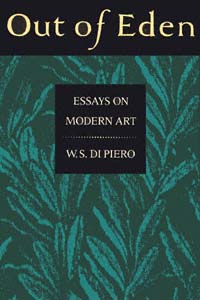 | Title: Out of Eden: essays on modern art Author: Di Piero, W. S Published: University of California Press, 1991 Subjects: Art | Art Criticism Publisher's Description: Out of Eden presents the rigorous investigations and musings of a poet-essayist on the ways in which modern artists have confronted and transfigured the realist tradition of representation. Di Piero pursues his theme with an autobiographical force and immediacy. He fixes his attention on painters and photographers as disparate as Cezanne, Boccioni, Pollock, Warhol, Edward Weston, and Robert Frank. There is indeed a satisfying sweep to this collection: Matisse, Giacometti, Morandi, Bacon, the Tuscan Macchiaioli of the late nineteenth century, the Futurists of the early modern period, and the American pop painters.Di Piero's analysis of modern images also probes the relation between new kinds of image making and transcendence. The author argues that Matisse and Giacometti, for example, continued to exercise the religious imagination even in a desacralized age. And because Di Piero believes that the visual arts and poetry live intimate, coordinate lives, his essays speak of the relation of poetry to forms in art. [brief] Similar Items |
| 9. | 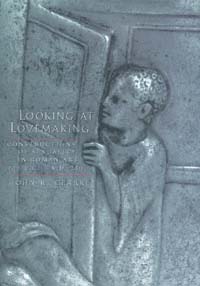 | Title: Looking at lovemaking: constructions of sexuality in Roman art, 100 B.C.-A.D. 250 Author: Clarke, John R 1945- Published: University of California Press, 1998 Subjects: Art | Classics | Art and Architecture | Art History | History | Gender Studies Publisher's Description: What did sex mean to the ancient Romans? In this lavishly illustrated study, John R. Clarke investigates a rich assortment of Roman erotic art to answer this question - and along the way, he reveals a society quite different from our own. Clarke reevaluates our understanding of Roman art and society in a study informed by recent gender and cultural studies, and focusing for the first time on attitudes toward the erotic among both the Roman non-elite and women. This splendid volume is the first study of erotic art and sexuality to set these works - many newly discovered and previously unpublished - in their ancient context and the first to define the differences between modern and ancient concepts of sexuality using clear visual evidence.Roman artists pictured a great range of human sexual activities - far beyond those mentioned in classical literature - including sex between men and women, men and men, women and women, men and boys, threesomes, foursomes, and more. Roman citizens paid artists to decorate expensive objects, such as silver and cameo glass, with scenes of lovemaking. Erotic works were created for and sold to a broad range of consumers, from the elite to the very poor, during a period spanning the first century B.C. through the mid-third century of our era. This erotic art was not hidden away, but was displayed proudly in homes as signs of wealth and luxury. In public spaces, artists often depicted outrageous sexual acrobatics to make people laugh. Looking at Lovemaking depicts a sophisticated, pre-Christian society that placed a high value on sexual pleasure and the art that represented it. Clarke shows how this culture evolved within religious, social, and legal frameworks that were vastly different from our own and contributes an original and controversial chapter to the history of human sexuality. [brief] Similar Items |
| 10. | 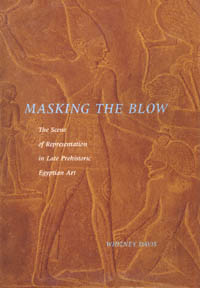 | Title: Masking the blow: the scene of representation in late prehistoric Egyptian art Author: Davis, Whitney Published: University of California Press, 1992 Subjects: Art | Art History Publisher's Description: The meaning of late prehistoric Egyptian images has until now been tantalizingly mysterious, as little understood as the circumstances of their production. As a result, analyses of these images have been general and often incorrectly illustrated. Whitney Davis now provides a welcome remedy in this detailed reinterpretation of the images carved on ivory knife handles and schist cosmetic palettes. These images are among the most important documents of early Egyptian history and include the Narmer Palette, often considered the very inception of ancient Egyptian image making.Davis deciphers the intriguing pictorial narratives and complex metaphors of images that are concerned with "masking the blow" of the ruler. "Masking the blow" refers to the ways that the images - from hunted animals to human antagonists - represent, elide, or suppress the depiction of a ruler's violent act of conquering an enemy.Examining late prehistoric Egyptian images in light of contemporary visual theory and illustrating his analyses with excellent reproductions, Davis goes beyond the usual concern for stylistic development and iconographic meanings that characterize prior studies. His work will greatly interest art historians, archaeologists, anthropologists, and students of the visual arts. [brief] Similar Items |
| 11. | 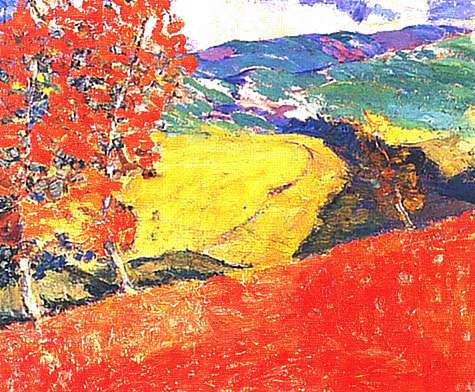 | Title: The Society of Six: California colorists Author: Boas, Nancy 1934- Published: University of California Press, 1997 Subjects: Art | Art History | California and the West | Californian and Western History Publisher's Description: Six plein-air painters in Oakland, California, joined together in 1917 to form an association that lasted nearly fifteen years. The Society of Six - Selden Connor Gile, Maurice Logan, William H. Clapp, August F. Gay, Bernard von Eichman, and Louis Siegriest - created a color-centered modernist idiom that shocked establishment tastes but remains the most advanced painting of its era in Northern California. Nancy Boas's well-informed and sumptuously illustrated chronicle recognizes the importance of these six painters in the history of American Post-Impressionism.The Six found themselves in the position of an avant garde not because they set out to reject conventionality, but because they aspired to create their own indigenous modernism. While the artists were considered outsiders in their time, their work is now recognized as part of the vital and enduring lineage of American art. Depression hardship ended the Six's ascendancy, but their painterliness, use of color, and deep alliance with the land and the light became a beacon for postwar Northern California modern painters such as Richard Diebenkorn and Wayne Thiebaud. Combining biography and critical analysis, Nancy Boas offers a fitting tribute to the lives and exhilarating painting of the Society of Six. [brief] Similar Items |
| 12. | 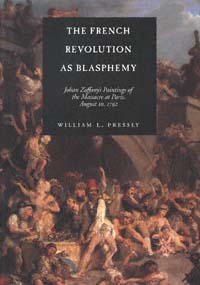 | Title: The French Revolution as blasphemy: Johan Zoffany's paintings of the massacre at Paris, August 10, 1792 Author: Pressly, William L 1944- Published: University of California Press, 1999 Subjects: Art | Art History | European History | French Studies Publisher's Description: William Pressly presents for the first time a close analysis of two important, neglected paintings, arguing that they are among the most extraordinary works of art devoted to the French Revolution. Johan Zoffany's Plundering the King's Cellar at Paris, August 10, 1792 , and Celebrating over the Bodies of the Swiss Soldiers , both painted in about 1794, represent events that helped turn the English against the Revolution.Pressly places both paintings in their historical context - a time of heightened anti-French hysteria - and relates them to pictorial conventions: contemporary history painting, the depiction of urban mobs in satiric and festival imagery, and Hogarth's humorous presentation of modern moral subjects, all of which Zoffany adopted and reinvented for his own purposes. Pressly relates the paintings to Zoffany's status as a German-born Catholic living in Protestant England and to Zoffany's vision of revolutionary justice and the role played by the sansculottes, women, and blacks. He also examines the religious dimension in Zoffany's paintings, showing how they broke new ground by conveying Christian themes in a radically new format.Art historians will find Pressly's book of immense value, as will cultural historians interested in religion, gender, and race. [brief] Similar Items |
| 13. | 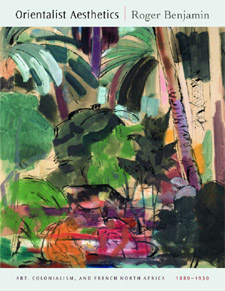 | Title: Orientalist aesthetics: art, colonialism, and French North Africa, 1880-1930 Author: Benjamin, Roger 1957- Published: University of California Press, 2003 Subjects: Art | Art History | French Studies Publisher's Description: Lavishly illustrated with exotic images ranging from Renoir's forgotten Algerian oeuvre to the abstract vision of Matisse's Morocco and beyond, this book is the first history of Orientalist art during the period of high modernism. Roger Benjamin, drawing on a decade of research in untapped archives, introduces many unfamiliar paintings, posters, miniatures, and panoramas and discovers an art movement closely bound to French colonial expansion. Orientalist Aesthetics approaches the visual culture of exoticism by ranging across the decorative arts, colonial museums, traveling scholarships, and art criticism in the Salons of Paris and Algiers. Benjamin's rediscovery of the important Society of French Orientalist Painters provides a critical context for understanding a lush body of work, including that of indigenous Algerian artists never before discussed in English. The painter-critic Eugène Fromentin tackled the unfamiliar atmospheric conditions of the desert, Etienne Dinet sought a more truthful mode of ethnographic painting by converting to Islam, and Mohammed Racim melded the Persian miniature with Western perspective. Benjamin considers armchair Orientalists concocting dreams from studio bric-à-brac, naturalists who spent years living in the oases of the Sahara, and Fauve and Cubist travelers who transposed the discoveries of the Parisian Salons to create decors of indigenous figures and tropical plants. The network that linked these artists with writers and museum curators was influenced by a complex web of tourism, rapid travel across the Mediterranean, and the march of modernity into a colonized culture. Orientalist Aesthetics shows how colonial policy affected aesthetics, how Europeans visualized cultural difference, and how indigenous artists in turn manipulated Western visual languages. [brief] Similar Items |
| 14. | 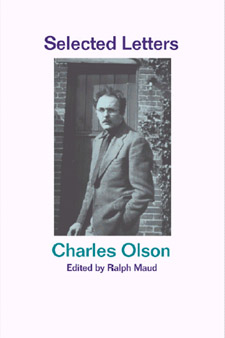 | Title: Selected letters Author: Olson, Charles 1910-1970 Published: University of California Press, 2001 Subjects: Literature | Poetry | Autobiographies and Biographies | American Literature | American Studies | Letters Publisher's Description: For Charles Olson, letters were not only a daily means of communication with friends but were at the same time a vehicle for exploratory thought. In fact, many of Olson's finest works, including Projective Verse and the Maximus Poems, were formulated as letters. Olson's letters are important to an understanding of his definition of the postmodern, and through the play of mind exhibited here we recognize him as one of the vital thinkers of the twentieth century. In this volume, edited and annotated by Ralph Maud, we see Olson at the height of his powers and also at his most human. Nearly 200 letters, selected from a known 3,000, demonstrate the wide range of Olson's interests and the depth of his concern for the future. Maud includes letters to friends and loved ones, job and grant applications, letters of recommendation, and Black Mountain College business letters, as well as correspondence illuminating Olson's poetics. As we read through the letters, which span the years from 1931, when Olson was an undergraduate, to his death in 1970, a fascinating portrait of this complex poet and thinker emerges. [brief] Similar Items |
| 15. | 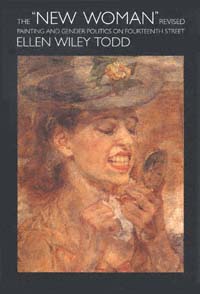 | Title: The "new woman" revised: painting and gender politics on fourteenth street Author: Todd, Ellen Wiley Published: University of California Press, 1993 Subjects: Art | Art History | United States History | Women's Studies | American Studies Publisher's Description: In the years between the world wars, Manhattan's Fourteenth Street-Union Square district became a center for commercial, cultural, and political activities, and hence a sensitive barometer of the dramatic social changes of the period. It was here that four urban realist painters - Kenneth Hayes Miller, Reginald Marsh, Raphael Soyer, and Isabel Bishop - placed their images of modern "new women." Bargain stores, cheap movie theaters, pinball arcades, and radical political organizations were the backdrop for the women shoppers, office and store workers, and consumers of mass culture portrayed by these artists. Ellen Wiley Todd deftly interprets the painters' complex images as they were refracted through the gender ideology of the period.This is a work of skillful interdisciplinary scholarship, combining recent insights from feminist art history, gender studies, and social and cultural theory. Drawing on a range of visual and verbal representations as well as biographical and critical texts, Todd balances the historical context surrounding the painters with nuanced analyses of how each artist's image of womanhood contributed to the continual redefining of the "new woman's" relationships to men, family, work, feminism, and sexuality. [brief] Similar Items |
| 16. | 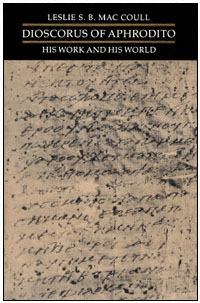 | Title: Dioscorus of Aphrodito: his work and his world Author: MacCoull, Leslie B Published: University of California Press, 1989 Subjects: Classics Publisher's Description: From the hand of Dioscorus of Aphrodito, sixth-century Coptic lawyer and poet, we have the only autograph poems to come down to us on papyrus from the late ancient world. Both the poetry he wrote for special occasions and the documents he produced in his legal career, in Greek and Coptic, reflect the major preoccupations of Dioscorus' society and his age: the nature of Byzantine imperial government, the patronage of the powerful elite, and the spirituality of the Egyptian Christian church. Thanks to residence in Egypt and many years of work with the original papyri, Leslie S. B. MacCoull is able to present a comprehensive picture of Dioscorus and his times. Through detailed analyses of the documents and poems, some previously unknown, she leads us to a fresh perception of the Coptic culture of Byzantine Egypt. She reveals the man and his world as inheritors of and contributors to the Egyptian-Classical-Christian fusion of society and intellectual life that gave birth to Gnosticism and the Desert Fathers. Dioscorus of Aphrodito epitomizes the little-known cultural flowering of late antique Egypt, which is now seen not as a place of sterility and decadence, but as the home of a strikingly original and creative culture whose subsequent eclipse still remains unexplained. [brief] Similar Items |
| 17. | 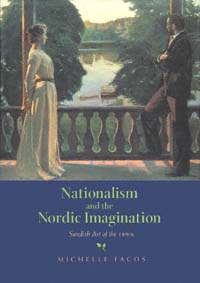 | Title: Nationalism and the Nordic imagination: Swedish art of the 1890s Author: Facos, Michelle Published: University of California Press, 1998 Subjects: Art | Art History | European Studies Publisher's Description: This richly illustrated book is a lucid introduction to a largely neglected manifestation of Modernism that came out of fin-de-siècle Sweden. Michelle Facos presents the first study in English to seriously examine the movement known as Swedish National Romanticism. Her work is especially valuable in showing how the movement's primitivist tendencies were related to, but different from, similar cultural forces in Germany and other parts of Europe at that time. Facos shows how a small group of Swedish artists espoused a politically progressive, culturally conservative form of nationalism. These artists - among them Carl Larsson, Bruno Liljefors, and Hanna Hirsch Pauli - produced a specifically national Swedish art by focusing on indigenous history, legends, and folk tales as well as uniquely Swedish-Nordic values, geography, and ethnography. Their breathtaking images of the Nordic landscape shaped a communal "Folk" identity that accented regionalism, solidarity, and attachment to the past and protested against the perceived dangers of capitalist industrialism and urban expansion. By 1900 Sweden was on its way to realizing a society of social, economic, and political equality, and the National Romantic painters were no longer renegades. Facos's portrayal of their movement will attract readers in the arts, historians, folklorists, cultural anthropologists, and sociologists. [brief] Similar Items |
| 18. | 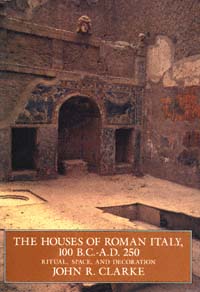 | Title: The houses of Roman Italy, 100 B.C.-A.D. 250: ritual, space, and decoration Author: Clarke, John R 1945- Published: University of California Press, 1992 Subjects: Classics | Art and Architecture | Architectural History | Art History Publisher's Description: In this richly illustrated book, art historian John R. Clarke helps us see the ancient Roman house "with Roman eyes." Clarke presents a range of houses, from tenements to villas, and shows us how enduring patterns of Roman wall decoration tellingly bear the cultural, religious, and social imprints of the people who lived with them.In case studies of seventeen excavated houses, Clarke guides us through four centuries of Roman wall painting, mosaic, and stucco decoration, from the period of the "Four Styles" (100 B.C. to A.D. 79) to the mid- third century. The First Style Samnite House shows its debt to public architecture in its clear integration of public and private spaces. The Villa of Oplontis asserts the extravagant social and cultural climate of the Second Style. Gemlike Third-Style rooms from the House of Lucretius Fronto reflect the refinement and elegance of Augustan tastes. The Vettii brothers' social climbing helps explain the overburdened Fourth-Style decoration of their famous house. And evidence of remodelling leads Clarke to conclude that the House of Jupiter and Ganymede became a gay hotel in the second century.In his emphasis on social and spiritual dimensions, Clarke offers a contribution to Roman art and architectural history that is both original and accessible to the general reader. The book's superb photographs not only support the author's findings but help to preserve an ancient legacy that is fast succumbing to modern deterioration resulting from pollution and vandalism. [brief] Similar Items |
| 19. | 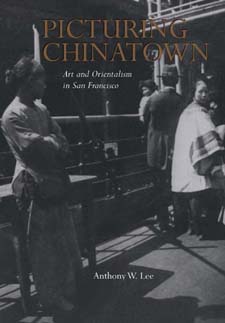 | Title: Picturing Chinatown: art and orientalism in San Francisco Author: Lee, Anthony W 1960- Published: University of California Press, 2001 Subjects: Art | California and the West | Asian American Studies | Photography | Art History Publisher's Description: This visually and intellectually exciting book brings the history of San Francisco's Chinatown alive by taking a close look at images of the quarter created during its first hundred years, from 1850 to 1950. Picturing Chinatown contains more than 160 photographs and paintings, some well known and many never reproduced before, to illustrate how this famous district has acted on the photographic and painterly imagination. Bringing together art history and the social and political history of San Francisco, this vividly detailed study unravels the complex cultural encounter that occurred between the women and men living in Chinatown and the artists who walked its streets, observed its commerce, and visited its nightclubs. Artistic representations of San Francisco's Chinatown include the work of some of the city's most gifted artists, among them the photographers Laura Adams Armer, Arnold Genthe, Dorothea Lange, Eadweard Muybridge, and Carleton Watkins and the painters Edwin Deakin, Yun Gee, Theodore Wores, and the members of the Chinese Revolutionary Artists' Club. Looking at the work of these artists and many others, Anthony Lee shows how their experiences in the district helped encourage, and even structured, some of their most ambitious experiments with brush and lens. In addition to discussing important developments in modern art history, Lee highlights the social and political context behind these striking images. He demonstrates the value of seeing paintings and photographs as cultural documents, and in so doing, opens a fascinating new perspective on San Francisco's Chinatown. [brief] Similar Items |
| 20. | 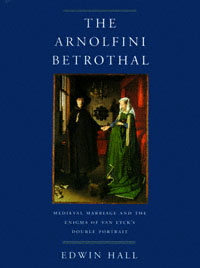 | Title: The Arnolfini betrothal: medieval marriage and the enigma of Van Eyck's double portrait Author: Hall, Edwin 1928- Published: University of California Press, 1997 Subjects: Art | Art History | Art Criticism | Medieval History Publisher's Description: Commonly known as the "Arnolfini Wedding" or "Giovanni Arnolfini and His Bride," Jan van Eyck's double portrait, painted in 1434, is probably the most widely recognized panel painting of the fifteenth century. One of the great masterpieces of early Flemish art, this enigmatic picture has also aroused intense speculation as to its precise meaning. Edwin Hall's accessible study - firmly grounded in Roman and canon law, theology, literature, and the social history of the period - offers a compelling new interpretation of this wonderful painting.Instead of depicting the sacrament of marriage, Hall argues, the painting commemorates the alliance between two wealthy and important Italian mercantile families, a ceremonious betrothal that reflects the social conventions of the time. Hall not only unlocks the mystery that has surrounded this work of art, he also makes a unique contribution to the fascinating history of betrothal and marriage custom, ritual, and ceremony, tracing their evolution from the late Roman Empire through the fifteenth century and providing persuasive visual evidence for their development. His illuminating view of Van Eyck's quintessential work is a striking example of how art continues to endure and engage us over the centuries. [brief] Similar Items |